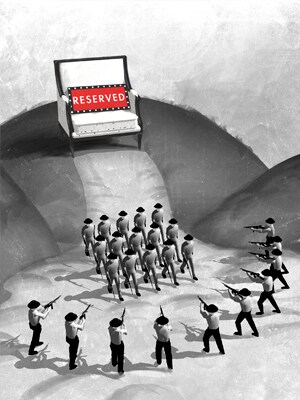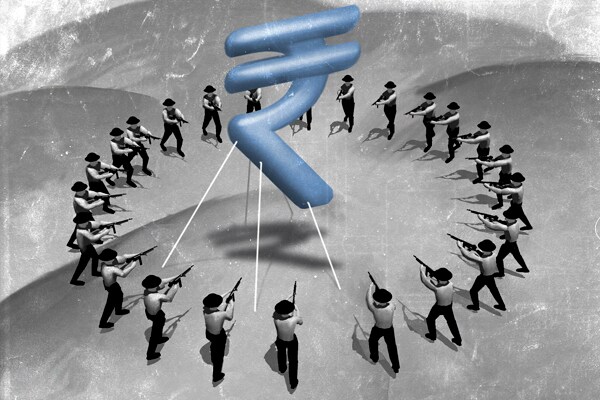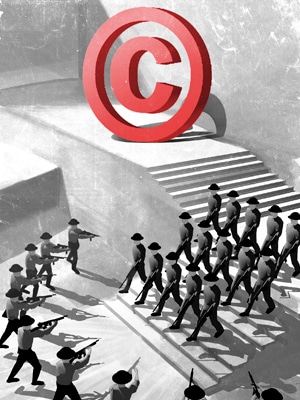
Battleground India: Nine Major Conflicts Shaping Your Life
Nine political, economic and social conflicts that will come under the limelight in 2011 and define the way India is governed
In 15th century Europe, the Borgias were one of the prominent ruling families. One of the Borgias, Rodrigo, became the Pope. Another, Cesare, wanted to become the king of Italy, but was thwarted by malarial fever sweeping Rome.
The rule of the Borgias is remembered for horrendous things like murder, theft, bribery and palace intrigue. And yet Italy of that time also experienced the Renaissance. There were enormous advancements in art, science, philosophy, literature and technology. Perhaps that’s why Orson Welles, who directed Citizen Kane, once wrote: “In Italy, for thirty years under the Borgias, they had warfare, terror, murder and bloodshed, but they produced Michelangelo, Leonardo da Vinci and the Renaissance. In Switzerland, they had brotherly love, they had five hundred years of democracy and peace — and what did that produce? The cuckoo clock.”
India, perhaps not at the centre of a renaissance (not yet!) and surely not like the rule of the Borgias, is still the land of a million mutinies. These feuds look ugly but are essential to the way we are going to live. They will decide what we pay for energy, how we communicate, whether the societally disadvantaged get a job, whether the poor get food to eat and what their children’s future will be. How these fights end will influence our lives in ways that are hard to appreciate today. The year 2011 is going to be a particularly challenging one. The global economy is still in a funk. The Indian reforms agenda seems to have slowed down considerably. The country is deeply divided on some critical technology and policy issues. Among the many battles, we have picked the biggest nine that will reach a decisive moment in 2011 and impact us all.
1 Dial a Quota
Reservation in the Private Sector
by Dinesh Narayanan
In the last week of December, Indian industry got a nasty reminder from the government. In a letter to industry associations, the department of industrial policy and promotion asked why they had not moved ahead on a proposal to appoint ombudsmen for monitoring affirmative action. The government had, a couple of years ago, shocked industry with a plan to introduce job quotas for scheduled castes and tribes in the private sector.
 J.J. Irani, who was then a part of the team from the Confederation of Indian Industry (CII) that had met the Prime Minister, articulated the industry’s opposition to quotas, while advocating voluntary action. “We have made it clear that we are against quotas. We are against reservation. Any move to impose this through legislation will be unfortunate,” Irani had said in an interview in 2006. He went on to head the Affirmative Action Council at CII in 2009-10.
J.J. Irani, who was then a part of the team from the Confederation of Indian Industry (CII) that had met the Prime Minister, articulated the industry’s opposition to quotas, while advocating voluntary action. “We have made it clear that we are against quotas. We are against reservation. Any move to impose this through legislation will be unfortunate,” Irani had said in an interview in 2006. He went on to head the Affirmative Action Council at CII in 2009-10.
After much debate, it was decided that industry will voluntarily undertake affirmative action. It was also decided that industry chambers will appoint ombudsmen to oversee the efforts. Well, except for the Federation of Chambers of Commerce and Industry (FICCI), nobody else appointed ombudsmen. FICCI chose industrialist Y.K. Modi as its ombudsman, but he quit on December 15.
CII has not appointed an ombudsman, arguing that it does not have a legal mandate to create a position that may need semi-judicial powers. The third big industry body, the Association of Chambers of Commerce in India, has meanwhile nominated heads of its four regional chambers as ombudsmen.
According to a CII survey, its members in the western region employed about 23 lakh people at the end of 2010, of which about 16 percent were SCs and STs. The proportion was the same for South India. The survey found the ratio rising to 22 percent in the North and 24 percent in the East. CII says its affirmative action initiatives — it calls them 4Es, employability, education, entrepreneurship and employment — were well on track.
An official, speaking on condition of anonymity, says that industry’s position is that caste never came in the way of jobs in the private sector. “The government is right in saying that SCs and STs should get more chances, but our members are also right in their stand,” the official says.
Many in the industry agree that affirmative action is necessary, but regard the government’s move as a political ploy to get votes as five states will go to polls this year. Besides, Uttar Pradesh, where caste plays a key role in making or breaking governments, will elect a new Assembly next year. Considering the political sensitivities of the issue and industry’s dislike of control, the matter is likely to simmer for a while.
2 The Flare Up
Natural Gas Pricing
by Cuckoo Paul & T. Surendar
If you thought there was a surfeit of news about the pricing of natural gas last year thanks to the fight between the Ambani brothers, be prepared for some more. The government plans to create a ‘gas pool’, where gas from domestic and international sources will be bundled, to be sold at a common price.

Now that is easier said than done, with imported LNG costing over $10 per million British thermal units (MMBTU) and the biggest domestic supplier Reliance Industries’ gas sold at just $4.2. The common pool price will be somewhere in the middle. But the path to arrive at an acceptable price for gas is a minefield.
For starters, RIL already wants a higher price over that arrived at by the Empowered Group of Ministers (EGoM) two years ago. It says the cost of drilling has gone up. RIL is producing significantly lower quantity of gas than projected initially. But the EGoM had fixed Reliance’s KG Basin gas price for five years; any move to increase prices will face opposition from the large users in the power and fertiliser industries.
Secondly, as more and more companies and city distribution networks sign up for gas, the government is also worried about the disparity in the pricing of imported gas as compared to the KG Basin gas.
Pooling the gas will neutralise the price difference and even out the anomaly created by different prices to different customers. A senior industry professional says that Reliance would be opposed to this scheme if the price it realises for its gas remains at $4.2 per MMBTU. But if the government increases the price for KG Basin gas to $6, it might back the scheme.
Firms like Petronet LNG will benefit from gas pooling. Currently, importing gas at $10 and selling it is not viable for them because local gas is available cheap. With the gas pool, they will be able to import and sell to more customers. This will be possible because the pool will fund any loss between imported price and sale price.
3 Time for Redial
Telecom Deserves a New Deal
by Shishir Prasad
He is a good man. He is a knowledgeable man. He is one of the few ministers in the cabinet who can understand technology and law,” says the CEO of a Telecom company, “But the best thing Kapil Sibal can do is to make himself redundant.” Sibal met the CEOs of all telecom companies on December 22, 2010, and has said that in 100 days he will clean up the mess and lay down the framework for a new telecom policy. Before peace can reign, he must end the battle that is raging at the moment.
 This latest trouble comes after three years of peace and started when the Comptroller and Auditor General released the report on the ‘scam’ in the sector about six months ago. Now the war has been joined by the politicians. Clearly, BJP and its allies see visions of 1989 when a similar CAG report destroyed the Rajiv Gandhi-led Congress government. They have revived a blood feud that involves two camps within the sector, the government and now, of course, political parties.
This latest trouble comes after three years of peace and started when the Comptroller and Auditor General released the report on the ‘scam’ in the sector about six months ago. Now the war has been joined by the politicians. Clearly, BJP and its allies see visions of 1989 when a similar CAG report destroyed the Rajiv Gandhi-led Congress government. They have revived a blood feud that involves two camps within the sector, the government and now, of course, political parties.
So what can Sibal do? He can cancel a few licences. A public interest litigation has already been filed in the Supreme Court on this. No doubt, it will be contested bitterly. Or he can ask all the mobile firms that received ‘excess’ spectrum to return it. This is impractical because the combined subscriber base of these players is very large and they would suffer; the companies will have a network planning nightmare on their hands, not to mention the resulting wealth destruction in their stocks. Sibal could instead levy a one-time charge to ‘regularise’ the connection! But all this will be open to litigation.
“Basically he has to declare a New Deal a la Roosevelt for the sector,” says an executive. Almost all players are unanimous on the three things he can do. First, he must set up an institution like the Securities and Exchange Board of India that is independent and has executive powers, to frame policy and allocate spectrum keeping only the consumer in mind. Two, he should make sure that if entry into the sector is free, then exit should be free too — that means, change the mergers and acquisitions norms. Three, he could attempt (but will probably find it hard to convince the home ministry, defence ministry and the Prime Minister’s Office) to move the Armed Forces to a different frequency band and free up spectrum. All this in 100 days? Well, it is nice to have a target!
4 Price Fighter
Pranab Da’s Tryst with the Impossible Trinity
by S. Srinivasan
Let us give you one career advice. If you are offered the job of India’s finance minister this year, politely decline. It is like solving the Rubik’s Cube with your eyes closed. By the time you fix one side, another goes for a toss and you don’t even know what you are doing.

Yet, be prepared to find Finance Minister Pranab Mukherjee presenting an optimistic Union Budget in February. It could show an economy growing at a scorching pace of 9 percent a year, fiscal and revenue deficits lower than targets and a resurgent external trade. The outlook will be bright with a speeding up of agricultural growth and a recovery in India’s biggest export market, the US.
But as always, the ugly truth will stay in the subtext.
It is the dream of the finance minister of any developing nation to have robust gross domestic product growth, an inflation rate that is under control and a current account deficit large enough to fuel the economy but too small to affect the balance of payments position. But in India, all three are showing signs of worsening in the next several months.
This is an election year. Tamil Nadu, Kerala, West Bengal and Assam will elect new Legislative Assemblies and for the United Progressive Alliance, the stakes are quite high in all of them. Pranab Mukherjee would want to keep the economy growing at 9 percent. A faltering growth rate could cost UPA votes, especially in the urban areas.
But allowing GDP expansion increasingly comes at a heavy price — inflation. The people, who are losing their purchasing power due to runaway food inflation of more than 18 percent, could show their anger in the voting. The government has to decide which option will lose fewer votes for the UPA — encouraging growth at the risk of rising prices or sacrificing growth and bottling inflation.
Since the current price rise is largely influenced by food inflation, the RBI’s control of money supply and raising of interest rates will not have much impact. People continue to buy food irrespective of their prices or RBI’s monetary stance.
It is then left to the government to make more vegetables and grains available to the people so prices may come down. But be it sugar or onion, Agriculture Minister Sharad Pawar has a miserable track record of ensuring supply. It will take years of agricultural reforms to free India from supply shocks.
The government has adopted a curious solution. It has linked wages under the rural job guarantee scheme to inflation. Even as prices increase, villagers will get more money in their hands. But this again will lead to more inflation, not less.
Next comes the question of the balance of payments. The current account deficit has skyrocketed by 72 percent to $15.8 billion in the second quarter to September. Economists fear it could rise above 3 percent of GDP in the 2010-11 fiscal year. It will deplete the foreign exchange reserves and scare away foreign investors.
In 2010, hot money from portfolio investors filled the gap in the current account. With the US recovering, this inflow into India could slow down. Foreign direct investment too is under strain. In the quarter to September, FDI fell to $2.5 billion as against $7.5 billion a year earlier.
What can the government or RBI do to contain this deficit? Cutting down imports is one option, but that will inhibit economic growth. In any case, rising commodity prices will not allow the import bill to come down. Boosting exports will be great, but it will require keeping interest rates low and the fight against inflation will be lost.
5 Shock Treatment
Electric vs. Hybrid
by Ashish K. Mishra & T. Surendar
There are several classifications under which vehicles get sops from the government — mostly by way of lower excise duty paid on the manufacturing costs. This is to encourage people to adopt certain types of vehicles, say small and fuel efficient cars. Now, in keeping with the times, the government is bringing in the ‘green’ factor for sops.

Electric cars will receive a subsidy of 20 percent of their ex-factory price, with a maximum limit of Rs. 100,000 per car; for two-wheelers the limit will be Rs. 5,000 per vehicle. The scheme is valid until 2012.
This is a welcome move but has auto-makers confused. Indian manufacturers are not clear which way the global technology is moving — all the way to pure electric vehicles (EVs) or towards hybrids that combine a petrol engine and a battery more and more efficiently to power the vehicle. An efficient pure EV is the Holy Grail, while hybrid offers an interim technology that is more affordable for consumers.
Says a senior Mahindra & Mahindra official: “If I bring in a technology which is going to pay back in one year or two years and also improves the environment and helps in reducing fuel consumption, then there is a market for it.”
Globally, the bigger subsidies and tax breaks go to hybrid cars. For instance, Toyota’s hybrid car Prius enjoyed subsidies in Japan as well as the US. But it’s different in India. The government worries that if it gives subsidies for hybrids, it may only end up encouraging manufacturers to introduce minimal modifications to qualify their vehicles as hybrids — the famous Indian jugaad. Manufacturers argue in favour of concessions for both EVs and hybrids — they can then put their money into whichever path they feel leads quicker to the market.
6 Thought for Food
Ensuring the Right to Eat
by Udit Misra
While we are looking to launch satellites and build highways and bullet trains, can we decide how we can feed even the poorest so that no one goes hungry? The UPA government had promised this during the 2009 Elections. Unfortunately, even the draft bill has not been finalised as yet.
Reason: The long-drawn tussle between key government departments like the food ministry and the Planning Commission on the one hand, and the social activists heavy National Advisory Council (NAC) on the other.
While the NAC is pushing for a far more comprehensive coverage of the Act, the government says it doesn’t have the resources, both financially and in terms of food grains. To implement the NAC proposals, the government would need to distribute nearly 70 million tonnes of food grains per year; the average procurement in the last three years has been around 55 million tonnes. To chisel down NAC’s proposals, the government has instituted a panel headed by C. Rangarajan. The debate continues.
7 Bio Dissimilars
Can We Have a Biotech Policy Please?
First, the Genetically Modified (GM) foods bandwagon was stopped in its tracks. Now the fate of the regulatory body that ‘appraises’ such foods — Genetic Engineering Approval Committee (GEAC) — is itself in doubt.

The government wants to bring in a new regulator under the proposed National Biotechnology Regulatory Authority (NBRA) Bill. As an autonomous, statutory body, NBRA will regulate research, manufacture and marketing of genetically modified organisms. This could, however, trigger turf wars. It could pit the Food and Safety Standards Authority (FSSA) against the NBRA, says the industry body, Association of Biotech Led Enterprises.
How exactly? Say, for instance, if GM tomato, the next readying crop in the government’s GM pipeline, is developed, it would fall under NBRA’s ambit, but the ketchup made from it would land in FSSA’s court.
Biotech companies (like Biocon, Bharat Biotech, etc) worry that makers of products like live vaccines and recombinant protein drugs would end up straddling both the offices.
Activist groups like Gene Campaign say the existing conflict of interest within the GEAC shouldn’t be perpetuated in the NBRA. A case in point: The Indian Council of Agricultural Research is a GEAC member and also a potential applicant for all the GM crops it is researching.
The food technology industry will not be able to move forward unless this conflict is resolved. Regulatory ambiguity is good for nobody.
8 Cure for Xenophobia?
Banning FDI in Pharmaceuticals
So, which is the largest Indian pharmaceutical company? It is Abbott Laboratories, which acquired Piramal Healthcare for $3.7 billion last year. After the sale of Ranbaxy’s business to Japanese firm Daiichi Sankyo in 2008, there are now three multinationals in the top five firms that rule the domestic market. And that has the government worried.
As the power balance shifts to multinational companies, it expects that prices of drugs will shoot up, making them expensive for the common man. In November, the government began toying with the idea of limiting foreign direct investment in the pharmaceutical sector to 49 percent through the foreign investment promotion board, as against 100 percent earlier.
Is that a good idea? Satish Reddy, managing director and CEO of Hyderabad-based Dr. Reddy’s Laboratories, doesn’t think so. “Instead of new restrictions, the government should create an environment to attract new local investment into the sector,” he says.
On the flipside, D.G. Shah, an experienced pharma executive and head of Vision Consulting, says that the current norms don’t bring additional investment into the sector — they only move assets to players with deeper pockets. Will the new investment restrictions help keep drug prices down? Unlikely, it seems.
In India, unlike in America, generics are branded by companies and sold at a premium. In Germany, recently the government decided to buy generics through a tender-based system — only the cheapest manufacturer would make the cut. The move caused immense pain to local generic firms there; the market has shrunk by nearly 40 percent.
So, in India, local industry experts are worried that multinationals will sell expensive, patent products and also mass supply generics without branding them to take on Indian competition.
If this happens, Indian players will lose their existing businesses and will not have the firepower to fight multinationals.
Besides, Indian firms like Sun Pharma and Dr Reddy’s get more revenue from overseas markets as the local market has become extremely cost competitive. This has further become a problem because they have fewer new products to launch as they can no longer copy from multinationals.
In fact, what the government is doing already, makes sense. It is using the price control regulation to make sure multinationals don’t price drugs too high. The second step would be to offer research rupees to Indian companies.
9 Digital Wrongs
Protecting Intellectual Property Rights
by Rohin Dharmakumar
Imagine you are in the mood for some fun and so you create a spoof video, the sort that you find on YouTube everyday. If the changes proposed under the Indian Copyright (Amendment) Bill, 2010 come through, you won’t be able to do that.
 The bill explicitly recognises the technology protection measures that publishers wrap around their content, commonly known as digital rights management (DRM), but without placing any limitations on it.
The bill explicitly recognises the technology protection measures that publishers wrap around their content, commonly known as digital rights management (DRM), but without placing any limitations on it.
So there’s a good chance a parody clip that uses video clips from a news show or of a baby dancing to the tune of ‘Sheila ki Jawani’ could be taken down by over eager copyright owners.
Pranesh Prakash, a program manager with Bangalore-based Centre for Internet and Society, a non-profit civil society policy advocacy and research body, says such a scenario is perfectly possible under the proposed new law. “Providing legal backing to technological protection measures without imposing appropriate duties means that companies can effectively expand their rights to whatever technology can do. It’s a ridiculous situation,” he says.
Even worse, the law provides for criminal liability for breaking such DRM. Ask the Indian developers behind ‘PlayFair’, an open source software that allowed consumers to bypass Apple’s FairPlay DRM.
The developers were forced to stop their project even though Apple challenged them under the US DMCA law, which has no jurisdiction in India. They still folded because as individuals they didn’t have the wherewithal to challenge Apple in a court.
“Our basic principle is that generally large corporations have the wherewithal to go to court and get orders, but individuals don’t. That balance must be maintained in the law, that everything isn’t presumptively violative of the law,” says Prakash.
Many fear of what might happen when digital rights management actually starts getting protection under Indian law. Raman Jit Singh Cheema, a policy analyst with Google India’s legal team, says the present version of the amendment is unclear on intermediary liability and ‘fair dealing’. Simply put, if a user does something illegal, even the service provider or search site that was used may become liable for the offence.
“Unless the government or a court of law interprets it otherwise, this could mean users submitting their content for approval before uploading, with approvals taking months due to the volume of information on the Internet,” says Cheema.
(This story appears in the 30 November, -0001 issue of Forbes India. To visit our Archives, click here.)





